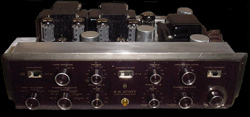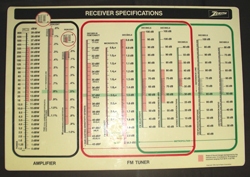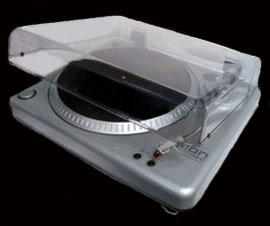Audio
Serious home audio started to evolve in the 60's with brand names such as Acoustic Research (AR), Crown, Kenwood, Mcintosh, Marantz, Sherwood, H.H. Scott, and Pioneer. These units provided superior clean audio signals for the new ported 4- and 8- ohm speakers, all rated in Root Mean Square (RMS) values. RMS was the true measure for actual power in watts, a value eventually required by law to be stated on every component advertised and displayed for sale. This had occurred because of consumers being burned by fluffy-stated power ratings like Total Music Power, some manufacturers using the term to make their under-performing audio products look impressive on a spec sheet to buyers who didn't know any better. Some amplifier / receiver systems supported four speakers, with some units featuring matrix-mixing circuits that created surround four-channel sound. Early audiophile sets were tube amplifiers, the professional Crown running so hot you could almost cook eggs on top of the steel case. Tubes provided zero hiss, allowing the amp to run hot on the volume. Silent spaces in between the audio were so dead silent to the ear, that if you would walk into a room with a tube system running during a silent space on a FM stereo radio station, common to classical transmissions, you would literally jump out of your skin when the announcer started to talk.
Crown Amplifiers also had a famous "butterfly circuit" that was designed to cut out almost all pops from a diamond needle tracking on a 33-rpm record groove, (called vinyl today.) Older records could suddenly sound brand new when preserved on reel-to-reel, 7 1/2 inch-per-second tapes that were recorded using the audio outputs on one of these Crown Amplifiers. The butterfly circuit provided almost perfect transfer of the record's content, eliminating annoying "pops" for later enjoyment when played back on the tape.* Tube amplifiers could not be damaged by an accidental shorting of a speaker output while the amp was running. Solid-state amplifiers, on the other hand, would instantly fry the power output transistors if the speaker output wires were ever accidentally touched while the amp was on. The tech rule was simple, and it was called a race. The question was, "Which would win, the amplifier or the fuse, when the output was accidental shorted . . . the race measured in a blink of the eye?" Specifications You might be interested in a spec comparison chart I produced for Zenith working with the engineer who developed FM stereo radio. The chart was designed to help audio buyers to understand power ratings and other specs that were written on any brand-name's spec sheets for their amp and tuner section.
I had also talked with a professor at a university in Tennessee, asking him how sound values were determined. He told me decibels were assigned based on the the way the human ear heard sounds. These studies discovered that for the ear to perceive only a change in the volume, there had to be a +3dB change in the volume of the sound. If you wanted to hear twice the volume, you needed a +10dB change. The above RMS rules for power are not really difficult to understand. Here are a few simple examples to help you understand the above principle. To perceive a change in volume in a stereo amplifier, producing at the time 1 watt of RMS power, the amplifier's volume would have to be raised to 2 watts RMS, or twice the wattage. That would hold for any RMS value on the chart. So if the amp was instead producing 5 watts of RMS power, for the human ear to detect a change in the volume in that amplifier, the power would again have to be doubled, this time to 10 watts of RMS power. Doubling the wattage always raises the power by 3dB. Now let's say you owned an amplifier that had a top RMS rating of 10 watts and you wanted to upgrade to an amplifier with larger speakers that would produce not simply a change in volume, but twice the volume, your having moved out of an apartment and into a single-family home. To do this, you would have to shop for a new amplifier that was rated at +10dB's more than your current 10-watt amp, or a new amp with at least 100 watts of RMS power . . . that's ten times! That's the RMS power rules. To hear a "change in volume," the watts need to double. To "double the volume," the watts need to be multiplied by 10. It's physics meeting the human hearing. Here is another example of audio specs, this time an amp's THD value. In the 1970's, Total Harmonic Distortion (THD) measured in percent was a big factor for audiophiles when buying an amplifier, the lower THD the better. While a THD of 0% was desirable, it was electronically impossible. Some high-end amplifiers had ratings of .01 and .005 THD and perceived to be the best. But there's a rub. Studies showed that the human ear can't detect harmonic distortions below 1%. Therefore, if you bought an amp with a THD of .5%, you were buying an amp with the understanding that if the value changed for the worse up to 1% THD, it wouldn't matter to the ear. Anything else was money out of your pocket and imagination. So how about tuners?
If your house was located out in the boondocks, the Capture Ratio spec would be important to you. Capture ratio, measured in decibels, was best when the spec was low for increased sensitivity, allowing a FM tuner to pull in one station from another when both stations were close in frequency and strength to each other. This eliminated the annoyance of hearing two stations at once. Ratings under 1.5 decibel were acceptable, again the lower the better making the detection circuit more sensitive to weaker signals. However, here again is the rub. If you lived in a city with many stations, Capture Ratio had no meaning since all stations were located close to you, their signals powerful. Close frequencies were not assigned by the FCC in the same city, reserved instead for other cities or towns further away. This avoided reception problems as discussed above for the city dweller. But if you lived in the country and between cities, you can suddenly understand why Capture Ratio would be critical to you when buying an tuner. This little spec would help you to be able to enjoy your radio listening, even when similar strength signals near similar frequencies came from two different metropolitans hitting your radio's antenna at the same time. So Capture Ratio would be an important spec to someone living in the country, but probably not to someone living in the city. Today, tuners are rarely sold as a separate unit, being included with the amplifier for consumer applications. Unless you're buying for applications for dance clubs, professional theater installations, or commercial sound installations, you will not find separate amps and tuners that are affordable at consumer prices. When the tuner is with the amplifier as one unit, as with virtually all consumer products, the unit you're looking to buy is going to be referred to as a "Receiver." As we moved into the 80's, larger-wattage, home stereo systems were being bought to support the larger-than-life large-screen television systems that were becoming available in the marketplace, as mentioned in the last chapter. These audio systems evolved into today's sophisticated 5.1 Dolby multi-channel systems. Five speakers provided all audio frequencies and discrete channels needed for the full effect of the available surround sound, along with a solid belly-shaking woofer, which provided the sub-base sounds . . . some so low you could only feel them. Audio waves lower than 20 cycles are too low for the human ear to hear. But I've heard if these unheard frequencies are too loud and on too long, they can eventually make some people feel ill, their having no idea what's going on because they can't hear it. The coils in the woofer at the same time are getting very hot, so it's not wise to try this for very long or you could short-out windings in your sub-woofer's driver magnet.
On the other end of the frequency spectrum, if you buy an receiver (or amp) with high frequencies above 20,000 cycles, you're only buying it in case the frequency response lowers over time. That's because most people can't hear highs above 16,000 cycles. Those who have excellent hearing at this level will be able to sometimes sense the very high pitch when standing next to a working picture tube. The horizontal frequency of these CRT's is rated around 16,500 cycles.*** So if you're buying an amplifier / receiver with its high frequency spec rated above 20,000, you will not be improving what you hear. Instead, you probably be just irritating the family dog, assuming your speakers are capable of producing these higher frequency waves. Dolby 5.1, 6.1, and 7.1
You will find amazing realistic sound when using a Dolby stereo system to support your HDTV home theater experience, sounds that follow the action in the picture as if you were standing in the picture. However, the Dolby trademark symbols of 5.1, 6.1, and 7.1 are themselves not magic and easy to understand. Here is how to read them. The number in front of the dot (.) is the number of speakers the system will support. The number after the dot (.) explains that one sub-woofers is needed. Therefore, 5.1 means there are five speakers supported with one sub-woofer. 5.1 systems are also supported by 6.1 and 7.1 playback mediums, allowing the 5.1 to not become obsolete, the newer systems understanding what to do with the added channel(s) when they are played back into a 5.1 system. While speaker placement is important, subwoofer placement usually is not. Unlike mid and high-range frequencies, deep base frequencies are non-directional and why you may see some manufacturers making them into looking like end tables. For a simple yet complete description of Dolby 5.1, 6.1 and 7.1, (five, six, and seven speaker systems that support the use of a single subwoofer), click here to visit the folks at Home Entertainment and Entertainment Design.
As of this writing, there are 13-different playback configurations for listening to Dolby Pro-Logic systems. The descriptions can be found at Dolby's Web site you can check out by clicking here. There is also another great site that shows all the different home-stereo speaker configurations you can experience, along with prepping end-cable wires, something you might have taken for granted. If you haven't clicked on the above links, click here to view an interesting Web page filled with lots of valuable information on speaker setups in your home. Finally, when buying the very inexpensive new home theater amplifiers, watch out! The less expensive ones have very few options to connect to other audio sources like tape decks and pro turntables, or use sources such as free AM and FM radio. In fact, some may only be CD / DVD changers with a Dolby Surround Sound system built in. In fact and if you are a vinyl buff, I would highly recommend that you buy a phono preamp, which takes the insignificant signal created by a phono cartridge and boosts it up to the IEEE values of a standard audio-video input. I suggest you go online to an electronic parts discounter to find one. You will save money and also be able to find one supplied with an AC cord instead of a battery. I recommend this because it's getting very hard to find amplifiers today that have an input for a magnetic cartridge, that function treated instead as a value-added step-up feature if there is one at all. And don't be surprised in the following years that even these pre-amps may disappear, too. Also, be aware today's amplifiers are not like your father's Oldsmobile. The more expensive models allow you to place a microphone where you would be sitting, watching the HDTV program or DVD movie, allowing the amp to automatically decide exactly what matching volume levels are needed for your Dolby Surround System when you are in that position in the room. These amplifiers, without speakers, can start at $500 and zoom past $1,000 without batting an eye. For our surround theater sound, I purchased a 2004 Onkyo Home Theatre unit that Circuit City had advertised with a HDTV set, but could be bought separately. While I avoided using the surround unit's component input and output jacks for switching component video too, I discovered the units had so many input jacks on the rear for other applications that one could even mate it to an older DVD player that had preamp outputs for the five Dolby audio channels! The unit allows me to easily set the five speaker volumes decibel levels using white noise even while the audio is being used in a running Dolby application. It also tells inputs when they are going to use a standard stereo audio source output, Dolby Surround coaxial source output, or Dolby optical source output. And in case you don't want to use the five speakers that come with the bundled unit, it allows you instead to reset its output values for your own speakers, allowing you to input the sizes of an already existing woofer, tweeter, and midrange speaker. The unit also comes with a built in FM and AM tuner with antenna inputs. And the price will not take food off your table. In fact, with this unit I have to say that Circuit City really has the everyday Joe in mind who wants to update his audio system without taking out a loan. Hats off to its marketing department.
Relying on the Classics - option for audiophiles.
For me, I'm not ready to invest in a new Dolby audio systems yet for all my audio needs, instead strictly using one for Home Theater applications. Instead, for audio applications outside of HDTV watching, I still utilize a classic four-speaker stereo workhorse, the 1970's Magnavox MX-Series four-channel receiver with dual discrete surround-sound circuits with matching 15-inch base-guitar speakers serving as woofers. Tweeters and midrange speakers have adjustable controls, the speaker assemblies enclosed in large all-wood sealed cherry cabinets. I found for best sound, the further apart the speakers, the better. My speakers are actually placed twenty feet apart. Before I had purchased a separate Home Theater unit, I had used this stereo unit with my Sony rear-projection HDTV set and its own stereo speakers, which also provides their own sound right in the middle of the room. The unit has a unique audio output that is tied directly to the volume control of the HDTV set, allowing me to balance the audio with the older four-speaker stereo system. Of course, you don't get those unique individual sounds from five speakers when the audio has been sweetened by a Hollywood pro. But if you're on a budget and have a classic amp sitting around with four large speaker coils it can't wait to drive, you're in business until you want to upgrade.
The Record Turntable Returns for the Computer Age
Like early HDTV with Plasma screens that ran about $19,000, this new technology runs about $9,000, more if you want a model to also play those antique 12" records you have laying around. The unit will even play reasonably warped records, the manufacturer even claiming if you have a broken record you can simply put the pieces together on the turntable and hopefully the record will play. Even the laser beam track can be adjusted for severely worn records.
But for those of you who don't want to part with $9,000, try the new UBS turntables that run about $300 or less with available USB connecter for connection to your home computer. Most units even include a software package that allows you to get rid of the pops and hiss before you burn your favorite analog tracks to your computer's CD recorder. We've only seen one that comes with a 78 speed, but check the software when buying. And be aware that some don't come with a dust cover, either, so read the fine print and don't assume. But a few units do allow you to play 78 records on 45 speed and then rev them up to proper speed digitally with their included software. Yea, it's getting that easy! So for you Brubeck fans with an old Brubeck does Disney 33 album hanging around from the early 1950's, now you can salvage those delightful tracks since many Brubeck CD's are no longer available for purchase. We have a Brubeck Newport 58' reproduction CD from Japan, the going cost on eBay now over $200.
|
|
Index
|






